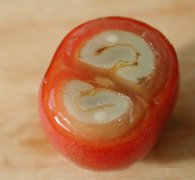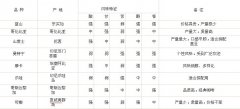High-quality coffee beans recommend the main coffee beans in Taiwan market.
Coffee trees are small shrubs growing in tropical highlands. Their fruits are red or yellow, and the seeds inside are what we call coffee beans. At present, coffee beans are grown in about 66 countries in the world, among which they can be classified as Arabica, Robusta and Liberica. Arabica is the largest major variety of coffee beans, accounting for about 80% of its aroma and quality. Robusta is mostly used to make instant coffee because of its poor quality. Liberica is seldom mentioned because of its poor quality and low yield. The unique flavor of coffee is irresistible, and the unique flavor is loved by everyone.
Now let's give a brief introduction to the main coffee beans in the Taiwan market:
Blue Mountain Coffee (BLUE MOUNTAIN)
Coffee beans are produced in the Blue Mountains of Jamaica at an altitude of more than 2500 feet. it is a kind of coffee with slightly sour, supple, sweet and delicate flavor. Pure Blue Mountain coffee has a light taste and flavor, but it is very mellow and delicate to drink. It has aristocratic taste and is the best coffee.
Mocha coffee (MOCHA)
At present, the coffee produced by Yemen is the best, followed by the mocha of Ethiopia; the mocha is extremely sour, sweet, unique and chocolate in its smoothness; it has the temperament of a lady and is a kind of pure coffee with unique characteristics.
Colombian Coffee (COLOMBIA)
Columbia coffee is the most characteristic of SUPREMO, its coffee is soft and mellow, with slight acid to medium acid, its quality and flavor are stable, it is a medium coffee, it is used to prepare comprehensive coffee.
Manning Coffee (MANDELING)
It is the most representative coffee produced in Indonesia and Sumatra. It has a strong flavor, strong and bitter taste, but it is supple and not sour. It is one of the best quality coffee produced in Indonesia.
Carbonated coffee (CHARCAL FIRE)
It is a kind of heavily roasted coffee, which tastes charred, bitter without sour, and coffee beans produce oil, so it is very suitable for steam pressurized coffee.
Brazilian Coffee (SANTOS)
Brazil is the world's first coffee producer, the coffee produced, mild flavor, slightly sour, slightly bitter, as the representative of neutral coffee, is an indispensable variety of mild coffee.
Kenyan Coffee (KENYA AA)
It is a typical coffee cultivated in the highlands of Africa. AA stands for its grade, that is, the highest grade, and its coffee beans are thick and round in meat, strong in taste and good in quality.
Hawaiian Coffee (KONA FANCY)
The coffee cultivated by the volcano in western Hawaii is also the only coffee variety produced in the United States. it has a strong taste, strong flavor, strong acid, and special flavor. The quality is quite stable and it is one of the local products that must be purchased by tourists going to Hawaii.
At present, the most important coffee beans mainly come from two varieties, namely Coffea Arabica and Coffea Canephore. The former is the so-called Arabica growing coffee beans. The latter is also known as "Robusta" to grow coffee beans. The plants, cultivation methods, environmental conditions, shape, chemical composition and even the processing methods of the subsequent raw beans of the two kinds of coffee beans are different. Generally speaking, the better and more expensive coffee beans come from coffee beans grown by Elaraby.
■ Arabica (Coffea Arabica)-
Account for 3/4 of the world's output, good quality, because the coffee tree itself is very sensitive to heat and humidity, so its growth conditions-at least 900m higher than the sea level of the highland climate, the higher the height, the better the quality of coffee beans baked. This variety has a low caffeine content (1.1-1.7%). The color of coffee beans is green to light green, oval in shape and curved in grooves.
■ Robasda (Coffea Robusta)-
It accounts for about 20%, 30% of the world's output. It has strong resistance to tropical climate and is easy to cultivate. It grows very well at a sea level of 200 mi 300 meters. However, its unique resistance also makes its concentration higher and its taste more bitter. Its caffeine content is high (2Mel 4%). Coffee beans are round in shape, brown in color and with straight grooves.
Coffee trees are small shrubs growing in tropical highlands. Their fruits are red or yellow, and the seeds inside are what we call coffee beans. At present, coffee beans are grown in about 66 countries in the world, among which they can be classified as Arabica, Robusta and Liberica. Arabica is the largest major variety of coffee beans, accounting for about 80% of its aroma and quality. Robusta is mostly used to make instant coffee because of its poor quality. Liberica is seldom mentioned because of its poor quality and low yield. The unique aroma of coffee is irresistible, and the unique flavor is loved by everyone.
Important Notice :
前街咖啡 FrontStreet Coffee has moved to new addredd:
FrontStreet Coffee Address: 315,Donghua East Road,GuangZhou
Tel:020 38364473
- Prev

Fine Coffee Science explains the internal anatomy of fine coffee beans in detail
Coffee bean close-up, coffee bean internal cross-section map of the coffee fruit after the peel of the freshly ripe coffee fruit on the tree, the coffee fruit without the peel, inside two coffee beans with endocarp, silver peel coffee bean coffee fruit internal structure (coffee fruit includes exocarp, mesocarp, pectin layer, endocarp, coffee bean silver skin, endosperm, embryo.) Internal knot of coffee beans
- Next

The Flavor of Coffee from Fine Coffee
After coffee beans spread to all parts of the world, due to the different climate, soil quality, planting methods and processing methods, the taste of coffee beans can be said to be completely different. Here is a list of the basic flavor characteristics of Arabica coffee beans from different producing areas (it should be noted that the flavor of coffee produced by different producing areas and different farms in the same place will be different. Some coffee products are generally believed to be
Related
- Beginners will see the "Coffee pull flower" guide!
- What is the difference between ice blog purified milk and ordinary milk coffee?
- Why is the Philippines the largest producer of crops in Liberia?
- For coffee extraction, should the fine powder be retained?
- How does extracted espresso fill pressed powder? How much strength does it take to press the powder?
- How to make jasmine cold extract coffee? Is the jasmine + latte good?
- Will this little toy really make the coffee taste better? How does Lily Drip affect coffee extraction?
- Will the action of slapping the filter cup also affect coffee extraction?
- What's the difference between powder-to-water ratio and powder-to-liquid ratio?
- What is the Ethiopian local species? What does it have to do with Heirloom native species?

